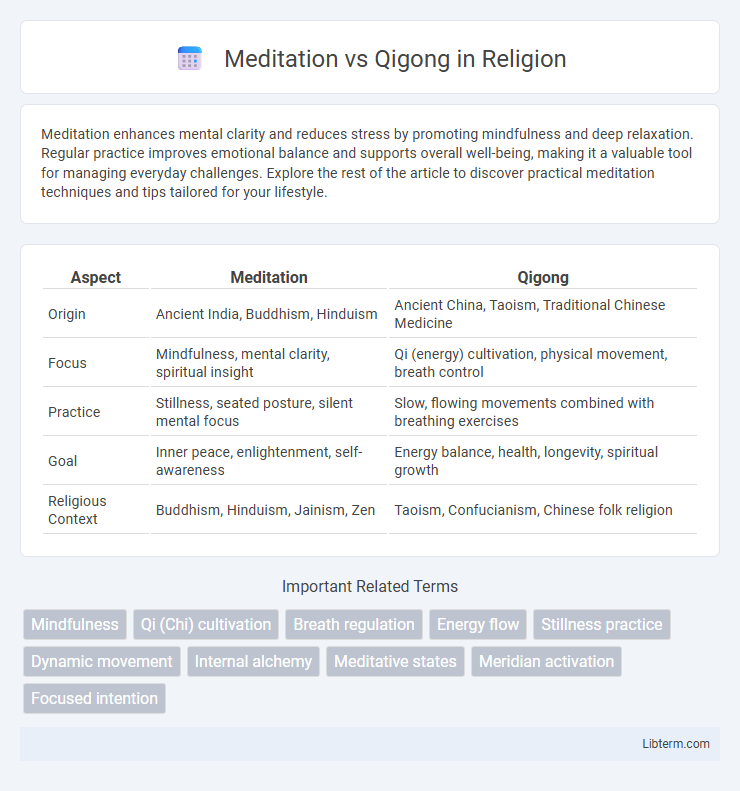Meditation enhances mental clarity and reduces stress by promoting mindfulness and deep relaxation. Regular practice improves emotional balance and supports overall well-being, making it a valuable tool for managing everyday challenges. Explore the rest of the article to discover practical meditation techniques and tips tailored for your lifestyle.
Table of Comparison
| Aspect | Meditation | Qigong |
|---|---|---|
| Origin | Ancient India, Buddhism, Hinduism | Ancient China, Taoism, Traditional Chinese Medicine |
| Focus | Mindfulness, mental clarity, spiritual insight | Qi (energy) cultivation, physical movement, breath control |
| Practice | Stillness, seated posture, silent mental focus | Slow, flowing movements combined with breathing exercises |
| Goal | Inner peace, enlightenment, self-awareness | Energy balance, health, longevity, spiritual growth |
| Religious Context | Buddhism, Hinduism, Jainism, Zen | Taoism, Confucianism, Chinese folk religion |
Introduction to Meditation and Qigong
Meditation and Qigong are ancient practices aimed at enhancing mental clarity and physical well-being, with meditation primarily focusing on mindfulness and mental relaxation through breath control and silent concentration. Qigong combines gentle physical movements, breath regulation, and meditation to cultivate and balance the body's vital energy, called "Qi." Both practices promote stress reduction and improved health, but meditation emphasizes inner stillness while Qigong integrates movement to harmonize body and mind.
Historical Origins and Philosophical Foundations
Meditation traces its historical origins to ancient India, rooted deeply in Vedic traditions and later systematized within Buddhist and Hindu philosophies emphasizing mindfulness and inner awareness. Qigong, emerging from ancient Chinese culture over 4,000 years ago, is grounded in Taoist and Confucian principles focusing on cultivating vital energy (qi) through coordinated movement, breath control, and meditation. Both practices share a philosophical foundation centered on harmonizing the mind and body but differ in methods and cultural context, reflecting their distinct historical trajectories.
Key Principles and Techniques Compared
Meditation centers on achieving mental clarity and mindfulness through focused attention and breath control, often practiced in stillness to cultivate inner peace. Qigong integrates coordinated body movements, breathing techniques, and mental focus to enhance energy flow (Qi) and physical vitality, blending dynamic postures with meditative awareness. Both disciplines emphasize breath regulation and mental concentration, but Qigong uniquely combines physical exercise with energy cultivation, whereas meditation primarily targets cognitive and emotional balance.
Mental Health Benefits: Meditation vs. Qigong
Meditation enhances mental health by reducing stress, anxiety, and depression through focused attention and mindfulness practices that promote emotional regulation and neuroplasticity. Qigong combines gentle physical movements, breath control, and meditation to improve mental clarity, balance mood, and decrease symptoms of anxiety and PTSD by stimulating the parasympathetic nervous system and enhancing energy flow. Both practices support mental well-being, but meditation primarily targets cognitive processes, while Qigong integrates physical and energetic components for holistic mental health benefits.
Physical Health Benefits: Similarities and Differences
Meditation and Qigong both enhance physical health by reducing stress and improving cardiovascular function, with meditation primarily lowering blood pressure and heart rate through deep relaxation techniques. Qigong combines physical movement, breathing exercises, and meditation, promoting balance, flexibility, and muscular strength alongside improved circulation. While meditation emphasizes mental calmness with indirect physical benefits, Qigong actively engages the body, offering a more dynamic form of exercise for physical wellness.
Practice Methods and Accessibility
Meditation primarily involves mental focus and breath control techniques aimed at enhancing mindfulness and reducing stress, often practiced in seated or stationary positions suitable for all ages and fitness levels. Qigong combines physical movements, breath regulation, and meditation, providing a holistic practice that improves energy flow, balance, and flexibility, typically requiring more physical engagement and coordination. Accessibility varies as meditation can be easily adapted for individuals with limited mobility, while Qigong may require guided instruction to master its dynamic movements safely.
Scientific Research and Evidence-Based Findings
Scientific research reveals meditation enhances cognitive function by reducing stress hormones and promoting neuroplasticity, supported by numerous neuroimaging studies. Evidence-based findings on qigong indicate improvements in physical balance, cardiovascular health, and immune function, with controlled trials demonstrating its role in reducing inflammation and chronic pain. Comparative studies suggest both practices benefit mental well-being, but meditation shows stronger effects on brain structure, while qigong offers holistic physiological advantages.
Choosing the Right Practice for You
Choosing between meditation and qigong depends on your goals and lifestyle, as meditation primarily enhances mental clarity and emotional balance through focused mindfulness, while qigong integrates physical movement with breath control to improve energy flow and overall vitality. Meditation practices like mindfulness or mantra meditation suit individuals seeking stress reduction and cognitive benefits with minimal physical exertion. Qigong offers a holistic approach combining gentle exercise and breath regulation ideal for those aiming to strengthen the body's energy system, flexibility, and relaxation simultaneously.
Common Misconceptions and Myths
Meditation and Qigong are often misunderstood as solely relaxation techniques, but they encompass deeper practices involving energy cultivation and mental clarity. Common misconceptions include the belief that Qigong is only a physical exercise or that meditation requires complete mental emptiness, whereas both integrate mindful awareness and subtle energy flow. Scientific studies highlight their distinct yet complementary benefits, such as improved cardiovascular health from Qigong and enhanced emotional regulation through meditation.
Integrating Meditation and Qigong in Daily Life
Integrating meditation and Qigong in daily life enhances mental clarity and physical vitality by combining mindful breathing, focused attention, and gentle movement. Regular practice promotes stress reduction, improves energy flow through meridians, and cultivates holistic well-being by balancing yin and yang energies. Establishing a consistent routine of 10-20 minutes each day maximizes the synergistic benefits of these ancient practices for overall health and tranquility.
Meditation Infographic

 libterm.com
libterm.com